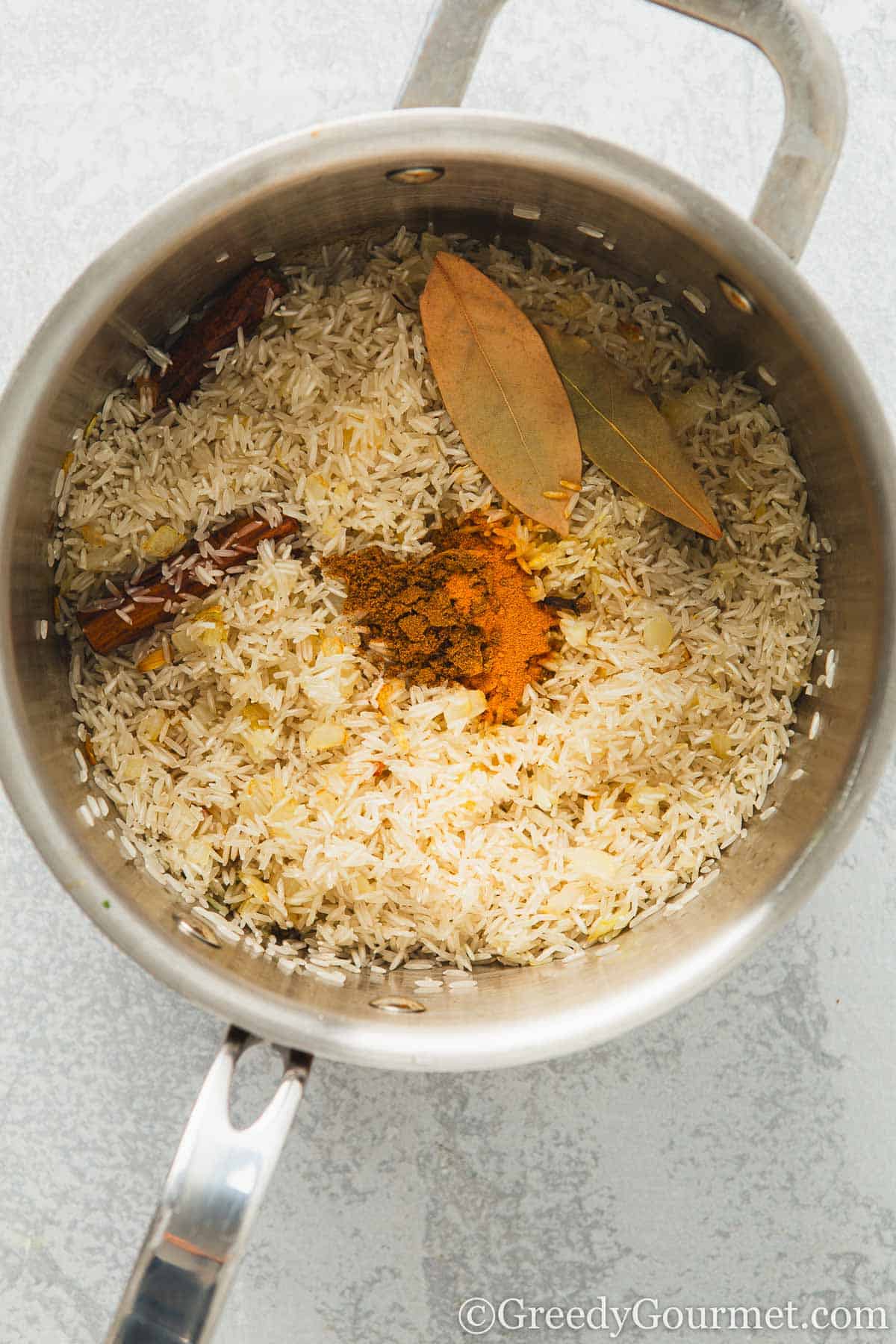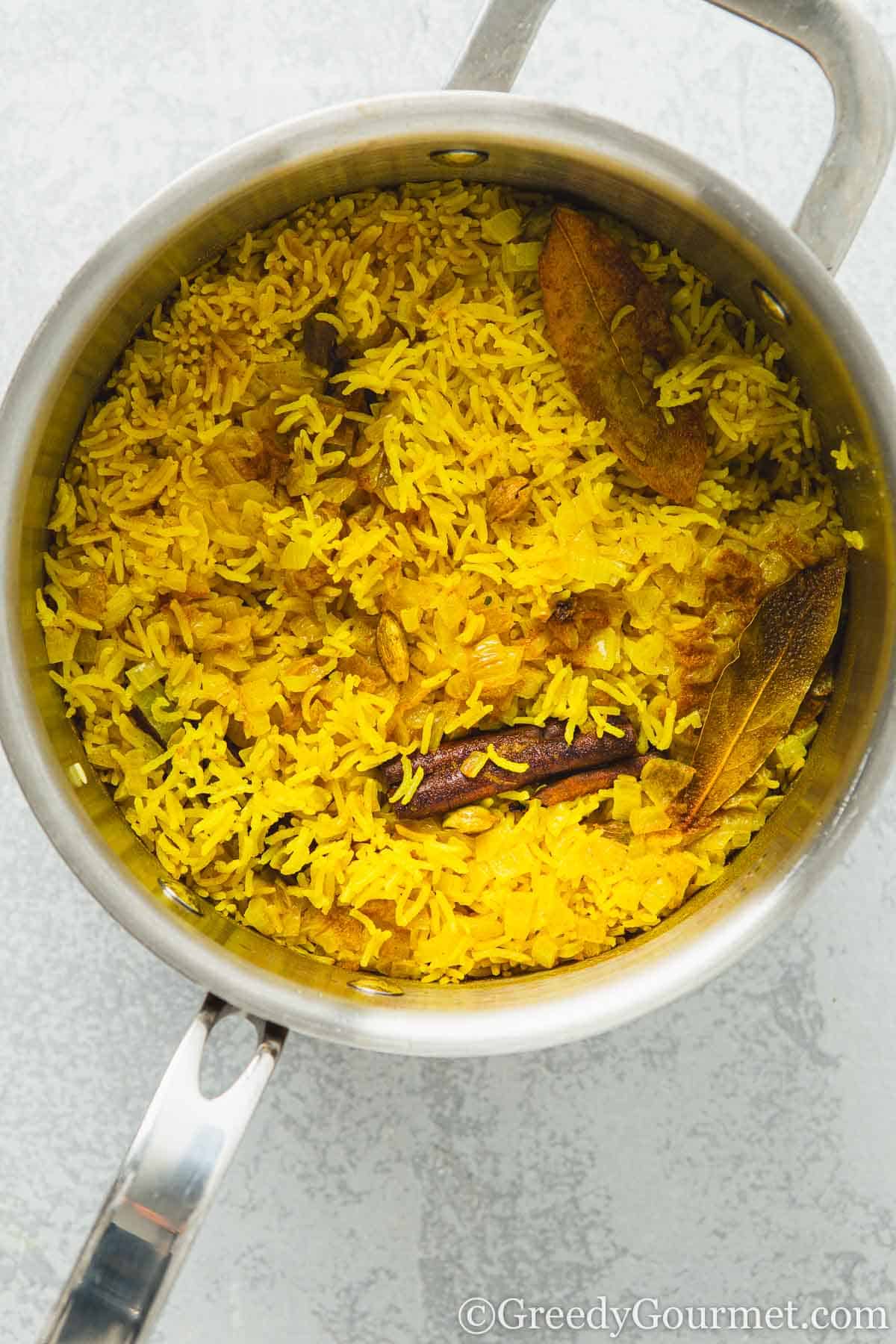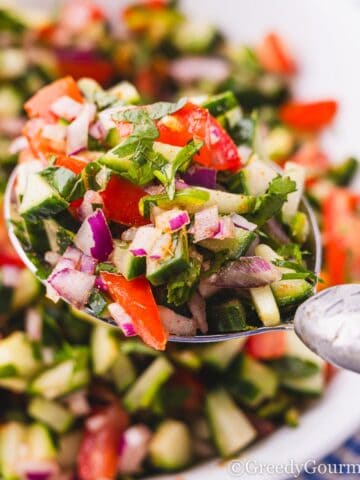Do you want to know the secret to making the perfect pilau rice? There’s nothing to it!

Cooking this Indian takeaway favorite only takes a few minutes longer than normal rice and you’ll need just a handful of ingredients. When it's done, you'll have an amazing side dish with incredible fragrance and a delightful, subtly spiced flavor.
Make your own pilau rice using white basmati rice and a few select spices, and pair this fabulous side dish with your favorite curries!
Why you'll love this easy pilau rice recipe
- So easy to make
- The spices are glorious
- It goes so well with all kinds of curries
- So much better than normal rice
Equipment you'll need
There are a few important items you’ll need before you get going with this homemade pilau rice recipe:
- Large saucepan with lid – a big sturdy cooking pan is a must for this pilau rice recipe
- Spice grinder – get the best out of your spices by grinding them fresh
- Serving dish – serve up your pilau rice in style
How to make pilau rice

- You need rice, onion, garlic, oil, bay leaf, whole cinnamon, whole cloves, cardamom pods, ground cumin and turmeric for this recipe.

- Fry fry the spices in a bit of oil first, then fry the onion for 5 minutes. Add the garlic and ginger and fry another 2 minutes before adding the rice.

- Give the rice a good stir then add the ground spices.

- Pour in the water and let it slowly simmer away until the rice has cooked and the liquid evaporated.

- Serve the pilau rice with your favorite curry. Enjoy!
What to Serve with Pilau Rice
- Chicken Curry: A classic pairing, the rich and flavorful sauce complements the fragrant pilau rice.
- Vegetable Curry: A mixed vegetable curry or aloo gobi (potato and cauliflower curry) offers a lighter, vegetarian option that pairs well with pilau rice.
- Lamb Kebabs: Juicy lamb kebabs or seekh kebabs add a hearty, meaty contrast to the rice.
- Chicken Tikka: Grilled chicken tikka is another excellent choice, with the pilau rice complementing the spices.
- Dal Makhani: This rich, buttery lentil dish pairs well with the aromatic rice, creating a comforting and satisfying meal.
- Cucumber Raita: A cool and refreshing cucumber raita balances the warmth of the pilau rice and any spicy main dishes.
- Mango Chutney: The sweetness of mango chutney provides a delicious contrast to the savory flavors of the rice.
- Kachumber Salad: A fresh, tangy kachumber salad adds crunch and acidity, enhancing the overall meal.
Top tips
- Use aged basmati rice for the highest quality pilau rice
- Freshly grind your spices for extra flavor and fragrance
- You don’t need to rinse basmati, just add it straight to the pan
- Use a high-quality sturdy saucepan to get a good distribution of heat, and make sure the lid fits properly
- While it’s possible to reheat leftovers, this tasty rice dish is definitely best eaten after serving
- For a real authentic Indian pilau rice, use ghee in place of vegetable oil
- After you’ve added all the ingredients, reached a simmering point, and put the lid on, turn the hob down to a low setting
Would you like to save this?
What is pilau rice made of?
Pilau is a fragrant rice dish cooked with select spices.
A million miles away from plain boiled rice, it tastes and smells like a dream. Looks-wise, it catches the eye with a wonderful vibrant yellow that makes it all the more appetizing.
Typical spices used in pilau rice vary, although cumin seeds, turmeric, cardamom pods, cinnamon, and bay leaves are standard.
Where does pilau rice come from?
The dish is typically served in Northern India, although the cooking technique comes from Persia, which is now known as Iran.
It's now a favorite curry throughout India, the UK, the US, and many places around the world.
When was pilau invented?
The earliest known recipe for pilau rice comes from a 10th-century Persian scholar. This old-school foodie and all-round genius – known as Avicenna to us in the West – wrote about the medicinal benefits of the day's dishes, including many pilau recipes.
While he might not have invented pilau, he documented it and was widely read. This has led to him being known as the father of modern pilau or pilaf.
There are plenty of theories that it goes all the way back to ancient times, with ancient Indian and Iranian civilizations said to turn their noses up at boiled rice in favor of the flavor of a spicy pilaf.
What's the difference between pilau and basmati?
Basmati is the type of rice used in the dish known as pilau. Basmati is a long, slender-grained aromatic rice. It’s traditionally grown in India, Nepal and Pakistan.

How do you store pilau?
Refrigeration
Leftover pilau can be stored in an airtight container in the refrigerator for up to 3 days. To prevent condensation, which can make the rice soggy, let the rice cool to room temperature before refrigerating.
Freezing
Pilau can be frozen for up to 1 month. To freeze, spread the cooled rice on a baking sheet for quick freezing, then transfer it to a freezer-safe container or resealable bag. Thaw overnight in the refrigerator or reheat directly from frozen.
How do you reheat pilau?
To reheat, use a microwave by placing the rice in a microwave-safe dish, adding a few drops of water, and heating in 1-minute intervals until warm. Alternatively, reheat on the stovetop by stirring the rice in a pan over medium heat, adding a splash of water or broth if needed. You can also reheat in the oven by covering the rice with foil and baking at 300°F (150°C) for 15-20 minutes. Always ensure the rice is heated thoroughly before serving.
How do you know when pilau rice is cooked?
The rice grains should be firm with a slight softness rather than stodgy or soggy.
Is it pilaf or pilau rice?
Pilau is sometimes called a pilaf, pilaw, pullao, or pilav, depending on the country where it’s being cooked. The word (or maybe we should say ‘words’) refers to the cooking technique rather than the dish itself.
The technique is to let the uncooked rice absorb ghee, butter, or oil while sautéed in a pan, while other ingredients, such as onion or chicken, are added before it’s all cooked in a simmering spiced stock.
Why is pilau rice yellow?
This yellow rice gets its glorious color from turmeric. Acting as a natural coloring agent, this sublime spice infuses the rice with its golden yellow color.
Can I use easy cook rice for pilau?
I recommend using classic basmati rice for this pilau rice recipe.
More amazing Indian side recipes
Spice up your sides and add some of these recipes to your homemade curry feast:
- Aloo ki kachori – a subtly spiced, round potato flatbread
- Gluten free puri – a small, round Indian flat bread made with simple ingredients
- Bombay chutney – the classic Indian chutney!
- Veggie puffs – little morsels of joy
- Pakora sauce – a delicious tomato-based sauce with hints of mint
- Potato bhajis – the UK’s favourite Indian side dish. These little beauts are so easy to make and utterly irresistible
📖 Recipe

Pilau Rice Recipe
- Total Time: 35 minutes
- Yield: 6 servings 1x
- Diet: Vegan
Description
Never order takeaway Pilau Rice again! Learn how to make the easy Indian side dish recipe in a few easy steps. Great with curries!
Ingredients
- 3 tablespoons vegetable oil
- 6 green cardamom pods, crushed
- 1 cinnamon stick, approximately 4 inches long
- 1 onion, finely chopped
- 1 garlic clove, crushed
- 2 cups basmati rice
- 1 teaspoon ground cumin
- 1 teaspoon ground turmeric
- 2 whole cloves
- 2 bay leaves
- 3 cups water
Instructions
- In a large saucepan, heat the vegetable oil over medium heat. Add the crushed cardamom pods and cinnamon stick, and fry gently for about 5 minutes or until the spices release their aromas.
- Add the finely chopped onion to the saucepan and sauté for about 5 minutes, or until the onion is softened and translucent.
- Stir in the crushed garlic and cook for another 2 minutes, stirring frequently to prevent burning.
- Tip in the basmati rice, ground cumin, ground turmeric, whole cloves, and bay leaves. Stir the mixture vigorously to coat the rice with the spices and oil.
- Pour in the 3 cups of water, stir once more, and then increase the heat to bring the mixture to a slow simmer.
- Once the water reaches a simmer, cover the saucepan with a tight-fitting lid. Reduce the heat to low and cook for about 15 minutes or until the rice is tender and fully cooked.
- Fluff the rice with a fork to separate the grains, then serve immediately with your favorite curry. Enjoy!
- Prep Time: 10 minutes
- Cook Time: 25 minutes
- Category: Side Dish
- Method: Boil
- Cuisine: Indian
Nutrition
- Serving Size:
- Calories: 302
- Sugar: 0.6 g
- Sodium: 6.7 mg
- Fat: 7.6 g
- Saturated Fat: 5.7 g
- Trans Fat: 0 g
- Carbohydrates: 53.4 g
- Fiber: 2.2 g
- Protein: 5 g
- Cholesterol: 0 mg





Jack
Better than uncle bens!
Michelle Minnaar
Thanks Jack!